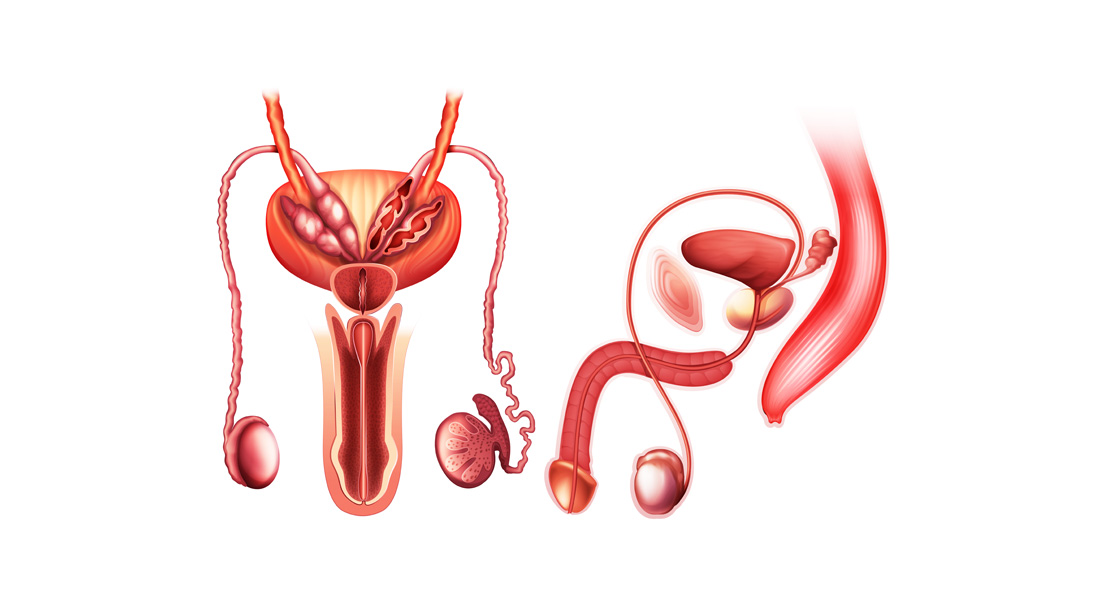The Male Reproductive System
The male reproductive system consists of structures located in the abdomen, pelvis, and perineum. The primary organs are the testis, epididymis, ductus deferens, and ejaculatory ducts, along with the urethra and penis. Accessory glands include the prostate gland, seminal vesicles, and bulbourethral glands. These structures work together to produce, store, and transport sperm, while also generating seminal fluid, which combines with sperm to form semen.
The Scrotum
- The scrotum is an external sac that hangs outside the abdominal cavity and contains the testes, epididymides, and the lower portion of the spermatic cords.
- It is divided into two compartments by a raphé, each housing one testis and one epididymis.
- Layers of the Scrotum:
- Skin: Thin, wrinkled, and pigmented, forming a single pouch.
- Superficial fascia: Contains smooth muscle fibers (dartos muscle), responsible for the wrinkling of the scrotal skin.
- Spermatic fasciae: Three layers derived from the abdominal wall muscles.
- Tunica vaginalis: A serous membrane that partially covers the testes.
Testes
- The testes are ellipsoid-shaped organs that develop in the abdomen and descend into the scrotum before birth. The left testis typically sits lower than the right.
- Covered by two membranes: the tunica vaginalis (a remnant of the peritoneum) and the tunica albuginea (a tough fibrous capsule).
- Inside each testis are lobules containing seminiferous tubules where sperm production occurs. These tubules lead to the rete testis, which connects to the epididymis via efferent ductules.
Epididymis
- The epididymis is a single, coiled duct located on the posterolateral side of the testis. It functions as the site of sperm maturation and storage.
- Divided into three parts: head, body, and tail.
- Head: Receives sperm from the rete testis.
- Body and Tail: Further mature sperm and transport them to the vas deferens.
Ductus Deferens (Vas Deferens)
- The ductus deferens is a muscular tube that transports sperm from the epididymis to the ejaculatory ducts. It travels through the inguinal canal, enters the pelvic cavity, and terminates by joining the seminal vesicle to form the ejaculatory duct.
- The ampulla of the vas deferens is a dilated terminal portion before the ejaculatory duct.
Seminal Vesicles
- The seminal vesicles are two lobulated glands located behind the bladder. They produce a fluid rich in fructose that nourishes sperm and makes up a significant portion of semen.
- Each vesicle joins with the ductus deferens to form the ejaculatory ducts, which pass through the prostate and open into the prostatic urethra.
Prostate Gland
- The prostate is a walnut-sized gland situated below the bladder, surrounding the urethra. It secretes a slightly acidic fluid that contains enzymes and prostate-specific antigen (PSA), contributing to semen's overall volume.
- The prostate consists of four anatomical lobes:
- Anterior lobe: Non-glandular tissue.
- Lateral lobes: The bulk of the gland.
- Median lobe: Located between the ejaculatory ducts and urethra.
- Posterior lobe: Palpable during a rectal examination.
Bulbourethral Glands
- The bulbourethral glands are small, pea-sized glands located beneath the prostate. They produce a clear mucus that neutralizes any acidic urine in the urethra and lubricates it for sperm passage during ejaculation.
Penis
- The penis is an external organ composed of three columns of erectile tissue: two corpora cavernosa and one corpus spongiosum. The corpus spongiosum surrounds the urethra and expands distally to form the glans penis.
- The skin covering the penis is thin and loose, and the foreskin (or prepuce) covers the glans unless circumcised.
- Blood supply to the penis comes from the internal pudendal artery, and venous drainage is via the internal pudendal veins.
Semen
- Semen is a mixture of sperm and secretions from the seminal vesicles, prostate, and bulbourethral glands.
- It contains prostaglandins, enzymes, and other substances that support sperm motility, protect them from the female immune response, and assist in sperm transportation within the female reproductive system.
Blood Supply and Lymphatic Drainage
- Testes and Epididymis:
- Blood supply: Testicular artery (branch of the abdominal aorta).
- Venous drainage: Pampiniform plexus, with the right testicular vein draining into the inferior vena cava and the left into the left renal vein.
- Lymphatic drainage: Para-aortic lymph nodes.
- Prostate:
- Blood supply: Branches from the internal pudendal, inferior vesical, and middle rectal arteries.
- Venous drainage: Prostatic venous plexus drains into the internal iliac veins.
- Lymphatic drainage: Internal iliac and sacral lymph nodes.
Nerve Supply
- The male reproductive organs receive sympathetic and parasympathetic innervation:
- Parasympathetic fibers (pelvic splanchnic nerves) are involved in erectile function.
- Sympathetic fibers (hypogastric plexus) mediate ejaculation and smooth muscle contraction in the accessory glands.



Free Videos